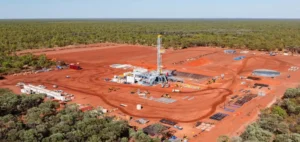LNG Canada, a joint venture led by oil group Shell, shipped its first cargo of 70,000 metric tonnes of liquefied natural gas (LNG) to South Korea on June 30. Despite this significant initial shipment, natural gas prices in western Canada have not registered the immediate recovery anticipated by some observers and market participants.
Price increase lower than expected
Located in northern British Columbia, the LNG Canada facility is expected to generate new daily demand of 2.1 billion cubic feet per day (bcfd). This additional demand aims to rebalance a market affected by several years of oversupply and low residential heating needs due to relatively mild winters. Currently, prices at the Alberta Energy Company (AECO), the main gas storage hub in western Canada, remain around $1.10 per million British thermal units (mmBtu), representing only about one-third of the U.S. Henry Hub benchmark price, according to data from the London Stock Exchange Group (LSEG).
Chris Carlsen, Chief Executive Officer of Canadian gas producer Birchcliff Energy, told Reuters: “We’re probably a dollar off where we thought we’d be in January.” This level remains low despite a modest recovery compared to the historical low point reached in 2024, then at $0.05 per mmBtu.
Continued rise in Canadian production
According to Trevor Rix, Director of Intelligence at Enverus, Canadian producers had already significantly increased their gas production in anticipation of LNG Canada’s commissioning. This production increase has contributed to the current gas surplus observed in the regional market.
Data from Canada’s energy regulator (Canada Energy Regulator) shows average Canadian production reached 18.35 bcfd in 2024. For the first quarter of 2025, production increased to an average of 19.24 bcfd, suggesting a new annual record if this trend continues until year-end.
Technical difficulties at the first train
Additionally, technical constraints are currently limiting optimal operations of the first liquefaction train (Train 1) at LNG Canada’s plant. Two sources close to the project cited by Reuters indicate this unit currently operates at less than 400 million cubic feet per day, significantly below its initial nominal capacity of one billion cubic feet per day, due to an issue with one of the production lines.
Repairs are currently underway and production should progressively reach full capacity by late August. The second train, meanwhile, is expected to reach full operation during next year. Mike Belenkie, Chief Executive Officer of Calgary-based producer Advantage Energy, notes that such ramp-up delays at new facilities are common in the LNG industry.
Strategic wait-and-see approach in gas market
Weather conditions in Canada, characterised by a relatively mild summer, are also contributing to maintaining the surplus by reducing natural gas consumption linked to air conditioning needs. Additionally, approximately 200 drilled but uncompleted wells are currently identified in the gas-producing Montney region in British Columbia, according to data from Enverus. This figure represents roughly twice the usual average.
This situation reflects a strategic position by producers, who prefer to delay bringing new wells online until gas prices show a more sustained upward trend.






















